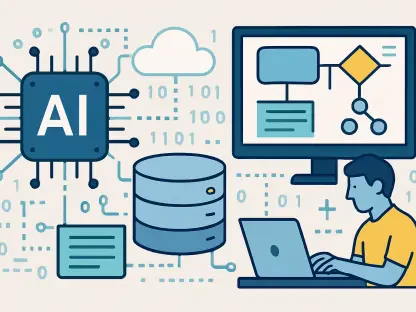Transfer learning is significantly revolutionizing machine learning, turning into a pivotal element in its advancement. This extraordinary method moves away from conventional practices where models are constructed entirely from the ground up for each task. Instead, it introduces a more effective approach that repurposes pre-existing models for new tasks. This major shift leads to reduced training times and lowered resource demands. Delving into the mechanics of transfer learning, examining its strategies, tackling inherent challenges, and recognizing its applications in real-world scenarios, are crucial steps to understanding how this innovative strategy is reshaping the landscape of machine learning.
The Mechanism Behind Transfer Learning
Hierarchical Feature Learning
Transfer learning taps into the hierarchical learning ability inherent in neural networks, making it a powerful tool across various domains. Neural networks learn to recognize basic elements like edges in initial layers, progressing to more complex structures and shapes in later layers. This feature hierarchy is crucial as transfer learning repurposes these generalized features to tackle new tasks, circumventing the need to train models from scratch. In transfer learning, the initial and middle layers of a pre-trained model are retained, with only the final layers requiring retraining for a new dataset. This ability to use previously learned features accelerates model adaptation and enhances versatility in complex tasks.
Moreover, transfer learning’s reliance on feature hierarchies offers a robust framework for reusing knowledge. Such a model can efficiently adapt to diverse tasks without extensive re-training, ensuring both speed and accuracy optimization. By leveraging previously acquired knowledge, transfer learning provides a solid foundation for new tasks, allowing neural networks to build on established insights. This attribute is paramount in scenarios demanding swift adaptation, be it in image recognition, natural language processing, or other domains. Transfer learning not only reduces the need for vast datasets but also fosters machine learning innovation by enhancing model flexibility and performance across varied applications.
Efficient Model Adaptation
Efficient model adaptation stands as a core principle within transfer learning, offering a transformative approach in applying pre-existing models to new tasks. Unlike traditional machine learning techniques that demand full-scale model development, transfer learning repurposes already-trained models, accentuating speed and efficiency. This innovation streamlines machine learning processes because only the new layers necessitate retraining, leveraging advanced features taught in prior contexts. Consequently, transfer learning avails itself of reduction in both time and computational resource burdens, facilitating expedited model deployment across diverse domains.
The essence of transfer learning lies in its ability to adapt models effortlessly and effectively to novel situations. Model adaptation can be swift and seamless through techniques such as fine-tuning, where minimal adjustments are made to a model’s pre-acquired weights. Fine-tuning allows the model’s foundational knowledge to be preserved while being calibrated for the specific nuances of a new task. This adaptability ensures not only a reduction in training duration but also enhances the overall accuracy and robustness of machine learning models, paving a path for advancements in scenarios requiring rapid deployment and flexible applications.
Advantages and Efficiency
Reduced Need for Large Datasets
Transfer learning’s significant advantage is its minimal dependency on large labeled datasets, revolutionizing machine learning efficacy. Pre-trained models have already acquired general features, diminishing the need for extensive data that is often cumbersome and costly to compile. This feature is particularly advantageous in domains like natural language processing and healthcare, where data acquisition can be challenging. The capability to work effectively with limited data allows for improved accuracy and renders machine learning more approachable and financially feasible for researchers and enterprises.
The minimization of data requirements through transfer learning enhances operational viability, especially for specialized applications. As models are repurposed rather than developed anew, extensive data collection processes become unnecessary, averting the logistical complexities often encountered when gathering and labeling vast datasets. This reduction in data reliance not only accelerates project timelines but also democratizes access to machine learning technology, empowering more stakeholders to engage in innovative developments within the field. Transfer learning’s framework fosters greater participation and exploration, broadening the spectrum of machine learning applications in various sectors.
Expedited Training and Deployment
One of the hallmark advantages of transfer learning is its role in significantly expediting both training and deployment processes, driving efficiency in machine learning endeavors. Standard methods typically necessitate prolonged training periods of models from scratch. Conversely, transfer learning allows only specific task adaptations, resulting in dramatically reduced training durations. Models can be swiftly deployed across various platforms, catering to industry demands for rapid prototyping and implementation. This advantage positions transfer learning as a catalyst in quickening the pace of technological innovation and application.
The streamlined training and deployment brought forth by transfer learning aid in meeting the rising need for fast, reliable machine learning solutions. As transfer learning taps into the reservoir of pre-existing knowledge, it permits swift adaptability to novel challenges, circumventing the lengthy processes associated with traditional model creation. This capacity for rapid deployment facilitates broad scalability within machine learning systems, granting industries greater agility in responding to market opportunities and technological shifts. The enhanced speed and precision underscored by transfer learning offer a robust framework for delivering cutting-edge models across varied sectors.
Approaches in Transfer Learning
Feature Extraction and Fine-Tuning
Various approaches within transfer learning, such as feature extraction and fine-tuning, underscore its versatile application. Feature extraction involves using a pre-trained model as a stationary feature extractor, channeling its insights into successive classifiers. This method capitalizes on the model’s learned knowledge to address subsequent challenges, eliminating the need for exhaustive re-training. Conversely, fine-tuning is deployed for intricate calibration of pre-trained models, adjusting select layers with precision while maintaining foundational insights. Such techniques facilitate adaptability and optimization of machine learning models to new responsibilities, enhancing performance without overshadowing previously garnered expertise.
Feature extraction and fine-tuning showcase transfer learning’s adaptability in diverse scenarios, extending its application scope. By leveraging existing models’ ability to discern essential features, these methods ensure streamlined transitions to novel arenas. While feature extraction facilitates an application-focused approach, fine-tuning allows for deeper calibration tailored to specific tasks, embodying a flexible combination of exploration and preservation. This dual approach highlights transfer learning’s capability in refining machine learning operations across multiple sectors, encouraging utilization of pre-trained models efficiently and effectively.
Domain Adaptation and Multi-Task Learning
Domain adaptation and multi-task learning further exemplify transfer learning’s strength in handling varied applications adeptly. Domain adaptation adjusts models to operate optimally across distinct data distributions between source and target domains, ensuring model efficacy despite variations. This process targets discrepancies that may arise from differing task environments, aligning model performance to diverse distribution contexts. Additionally, multi-task learning involves training models to tackle multiple, related tasks simultaneously, enhancing shared representations and collective understanding. This facet of transfer learning boosts models’ agility in balancing multiple demands, fostering skillful cross-task adaptation and comprehensive contextual awareness.
The versatility of approaches like domain adaptation and multi-task learning extends transfer learning’s reach across numerous applications, enriching model responsiveness. Domain adaptation’s focus on fine-tuning models for different distributions ensures consistent performance across diverse data ecosystems, while multi-task learning nurtures cross-task fluency, advancing shared interaction within model architecture. These strategies reflect transfer learning’s dexterity in navigating varied demands and provide extensive contributions to innovation, reliability, and seamless integration of machine learning solutions throughout diverse industries.
Challenges Faced in Transfer Learning
Negative Transfer
Despite its numerous advantages, transfer learning is not devoid of challenges, with negative transfer being a notable concern. Negative transfer emerges when the source and target tasks lack adequate similarity, potentially hindering rather than enhancing model performance. The risk arises because pre-trained insights may not translate effectively to different contexts, disrupting anticipated gains. Effective transfer learning demands strategic implementation, ensuring adequate cohesion between source and target domains to mitigate negative transfer impacts. Careful alignment between tasks diminishes these risks, underscoring the necessity for tactful application of transfer learning techniques.
The possibility of negative transfer underscores the significance of task compatibility in maintaining transfer learning effectiveness. Practitioners must ascertain coherence between training and target tasks to foster favorable transfers, cultivating environments where beneficial knowledge translation is maximized. This task alignment ensures transfer learning’s robust application while minimizing adverse consequences. Consideration of task congruity is essential, alongside rigorous examination of data context contributions, to optimize capable model performance and preserve transfer learning’s advantageous potential across distinct applications.
Overfitting and Domain Mismatch
Transfer learning also grapples with challenges such as overfitting and domain mismatch, necessitating astute management to thwart adverse effects. Overfitting can transpire during model fine-tuning if models become too narrowly adjusted to new datasets, clinging excessively to previously learned patterns. This challenge mirrors domain mismatch, where disparities in data distributions impede efficient transfer of knowledge across tasks. Both instances require strategic attention to avoid pitfalls. Adopting prudent fine-tuning methodologies and ensuring task similarity holds paramount importance to mitigate these risks, preserving transfer learning effectiveness.
Understanding data distribution and its bearing on model performance forms a crucial aspect of managing domain mismatch challenges within transfer learning. Identifying and reconciling the disparities between source and target datasets safeguards model adaptability, ensuring successful navigation of varied applications. Overfitting concerns demand meticulous observation of training practices, recombining previous insights with newfound task specifications while minimizing excess dependency. By incorporating precise evaluations and adjustments, transfer learning consistently unlocks advanced capabilities, driving productive innovation across machine learning initiatives.
Real-World Impact and Application
Diverse Industries Utilization
Transfer learning’s real-world applications span an impressively diverse range of industries, demonstrating its value in dynamically adapting models to specialized tasks. In natural language processing, transfer learning has revolutionized customer support and sentiment analysis by refining large language models like GPT and BERT for varied contexts. Similarly, in healthcare, transfer learning enhances diagnostic models for rare diseases by harnessing insights from broader datasets, thus expanding predictive accuracy and treatment potential. Computer vision also benefits, with models trained on extensive datasets easily adapting to precisely tasked challenges like medical imaging or wildlife surveillance.
Through pragmatic models trained and equipped with broader understanding, transfer learning accelerates innovative solutions across numerous sectors, fostering tailored applications. Its ability to adapt models efficiently ensures enterprises have access to cutting-edge technology that excels in specific tasks, refining processes and enhancing workflows. Transfer learning aids in bridging gaps between extensive data and targeted applications, gaining traction as a pivotal component in model adaptation for diverse industry requirements. The adaptability of transfer learning catalyzes technological advances and fuels improvements across fields ranging from autonomous vehicles to intricate speech recognition tasks.
Emergence of Foundation Models
The growing utilization of transfer learning is particularly prevalent in areas such as computer vision and natural language processing, underscoring its power to enhance both accuracy and efficiency. Embracing this change equips data scientists and AI developers with tools that optimize their workflow and maximize output potential.









